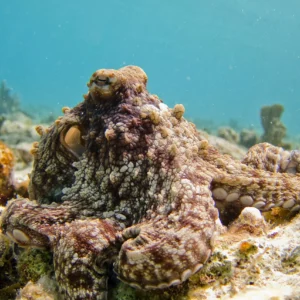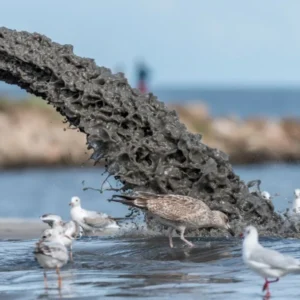In a world where human activities overexploit and deplete the Earth’s resources, jellyfish are increasingly emerging, challenging the notion that they are merely nuisances found along shores and in the sea. Long perceived as useless and harmful, recent revelations highlight the crucial role these gelatinous creatures play in the delicate balance of ecosystems. As climate change continues to cast its shadow on all living organisms, jellyfish are not exempt from direct impacts. Their presence in Tunisia has become more pronounced, with six distinct species gracing the country’s coasts, two exhibiting invasive tendencies. This surge in proliferation comes with consequences, posing challenges for fisheries, beachgoers, and the overall health of natural ecosystems.
Tunisia, Bizerte 2023

In the coastal haven of Bizerte, specifically in Ghar El Melh, celebrated for its stunning beaches and picturesque panoramas offering a magical swimming experience, an unwelcome presence has been increasingly felt. This elusive guest, often detected before it comes into view, carries stinging tentacles, causing intermittent and intense discomfort. These unwelcome visitors? Jellyfish. Devoid of a central nervous system and primarily composed of water, jellyfish are easily identifiable by their umbrella-shaped bodies, featuring two thin layers of cells separated by a watery substance. Despite their enchanting appearance, these marine creatures hold a dual reputation, being both fascinating and hazardous, evoking a mixture of admiration and fear, particularly among beachgoers and fishermen. Saber Kaabia, a young fisherman from Ghar El Melh, remarked on the escalating issue: “We’re witnessing a surge in jellyfish in our waters. They’re entangling in our nets, causing considerable inconvenience. They’re pervasive, varying in size, mingling with the fish in our nets, and even infiltrating aquaculture cages. It’s a burgeoning problem, and it’s causing concern,” Saber emphasized.
Worries are piling up with all these jellyfish appearing along our coasts. It’s not just about making swimming risky; our fisheries are taking a hit too. Are we heading towards a day when jellyfish outnumber fish in the nets?
S.Kaabia
Jellyfish revealed: A comprehensive exploration
According to Nausicaa, the French National Sea Center in Boulogne-sur-Mer, the jellyfish is a marine marvel that gracefully floats and swims, yet cannot resist ocean currents. Tracing its roots through fossils spanning an impressive 600 million years, this ancient marine species is predominantly composed of 95-98% water, granting it a distinctive gelatinous appearance and remarkable buoyancy.
Despite its seemingly simple composition—devoid of a brain, heart, lungs, and gills—the jellyfish breathes through the walls of its body. Contrary to its basic structure, it boasts a complete digestive system, featuring a mouth nestled among its tentacles and a stomach, muscles, and nerves forming a straightforward network of cells. Jellyfish showcases a fascinating array of sizes and shapes, from nearly invisible to the naked eye to impressive giants.
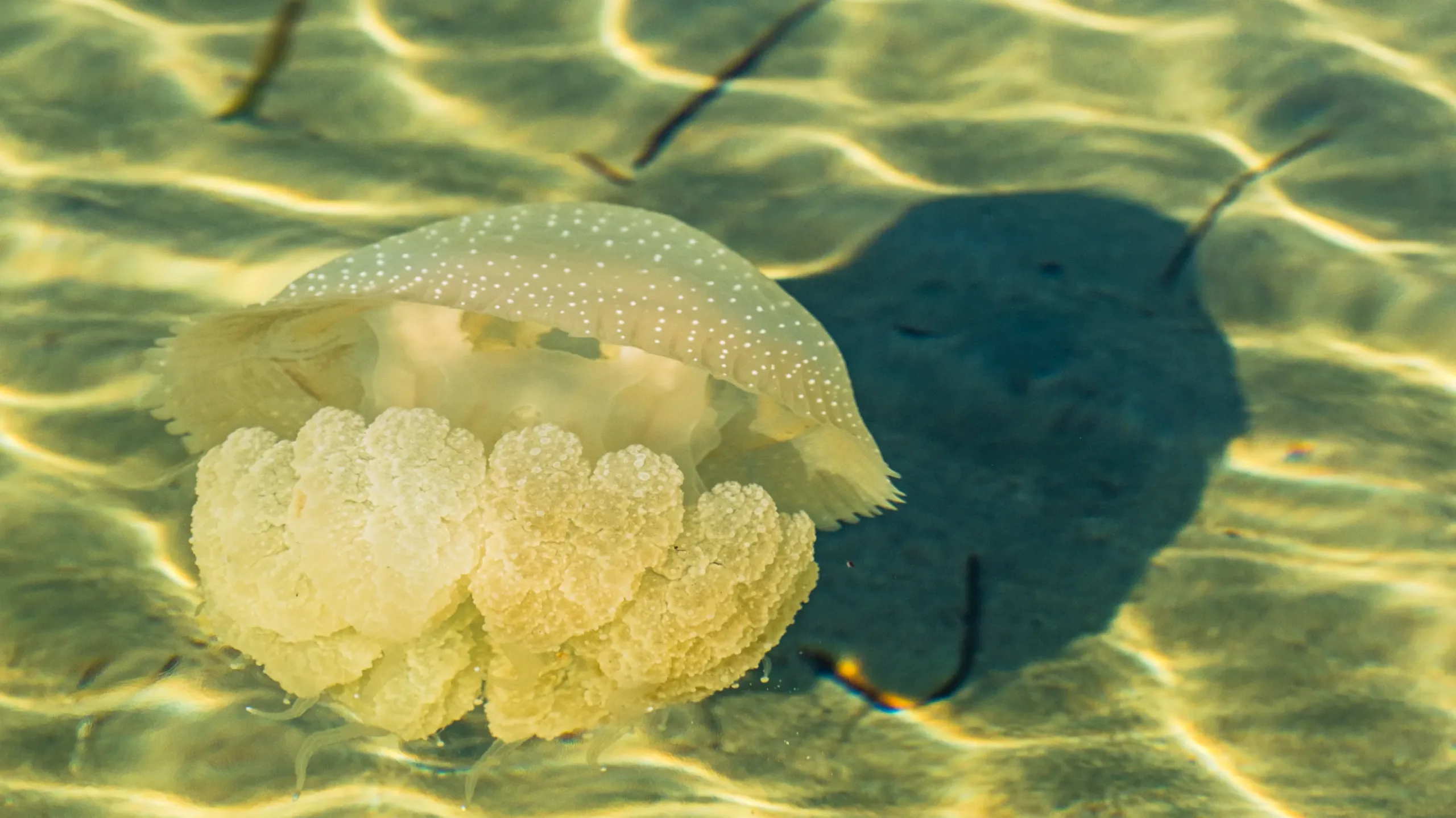
Dr. Sonia KM Gueroun, a Tunisian scientific expert with a Ph.D. specializing in jellyfish and their impact on the marine food chain, shared insights from her extensive research on these intriguing creatures. Reflecting on her academic journey, she expressed.
My fascination with jellyfish began during my research master’s, where I chose to delve into these creatures. This interest grew as I started working on microscopic jellyfish, Hydromedusa, and continued to evolve throughout my doctoral thesis, which focused on larger species.
Dr Sonia KM Gueroun
When we mention “jellyfish,” the common mental image often revolves around the larger ones swimming. However, the term encompasses several species of varying sizes, leading to widespread confusion. What we call “the true jellyfish”, scientifically termed Scyphomedusae, comprises around twenty species in the Mediterranean Sea, with six specifically identified in Tunisia. Expanding our lens to Medusozoa, an umbrella term including Scyphomedusae, Hydromedusae, and Cubomedusae, reveals an estimated 500 species in the Mediterranean, with 64 cataloged in Tunisia. It’s worth noting that the majority of these species fall within the microscopic realm, explains Dr. Sonia KM Gueroun.
The data gap: Unraveling the diversity of jellyfish in Tunisia
Dr. Gueroun, who manages the only monitoring network for jellyfish in Tunisia called “Meduses.Tunisie”, underscores a notable lack of information due to the diversity of six species. Although only 64 jellyfish species are documented in Tunisia, the Mediterranean teems with 500 species, exposing a significant gap in our understanding. Dr. Gueroun emphasizes that observing large jellyfish on beaches and in the sea is just the tip of the iceberg. Beyond our current knowledge, it is plausible that additional species exist, either in quantities too scarce to be visible or possessing non-traditional jellyfish characteristics, like the upside-down Cassiopea jellyfish, rendering their identification a challenging task for the public. Some species may be present but go unnoticed, particularly during the summer when beachgoers are most active.
Furthermore, Dr. Gueroun points out a seasonal bias in reporting, with minimal information flowing in during winter despite the continued presence of jellyfish. This accentuates the need for more comprehensive and year-round monitoring to enhance our grasp of Tunisia’s jellyfish population.
In Tunisia, we receive information and reports about jellyfish mainly during the summer. In winter, there’s almost nothing. However, winter sees a significant presence of jellyfish. We are likely underestimating the actual diversity, and there are probably more species yet to be observed.
Dr Gueroun
Common jellyfish species in Tunisian waters
According to Dr. Gueroun, the most commonly observed jellyfish species in Tunisia include Pelagia noctiluca, classified as a high-risk stinging species. Pelagia is present almost year-round along all Tunisian coasts but is particularly noticeable in winter, especially from November to February. Another regularly observed species is Rhizostoma pulmo.
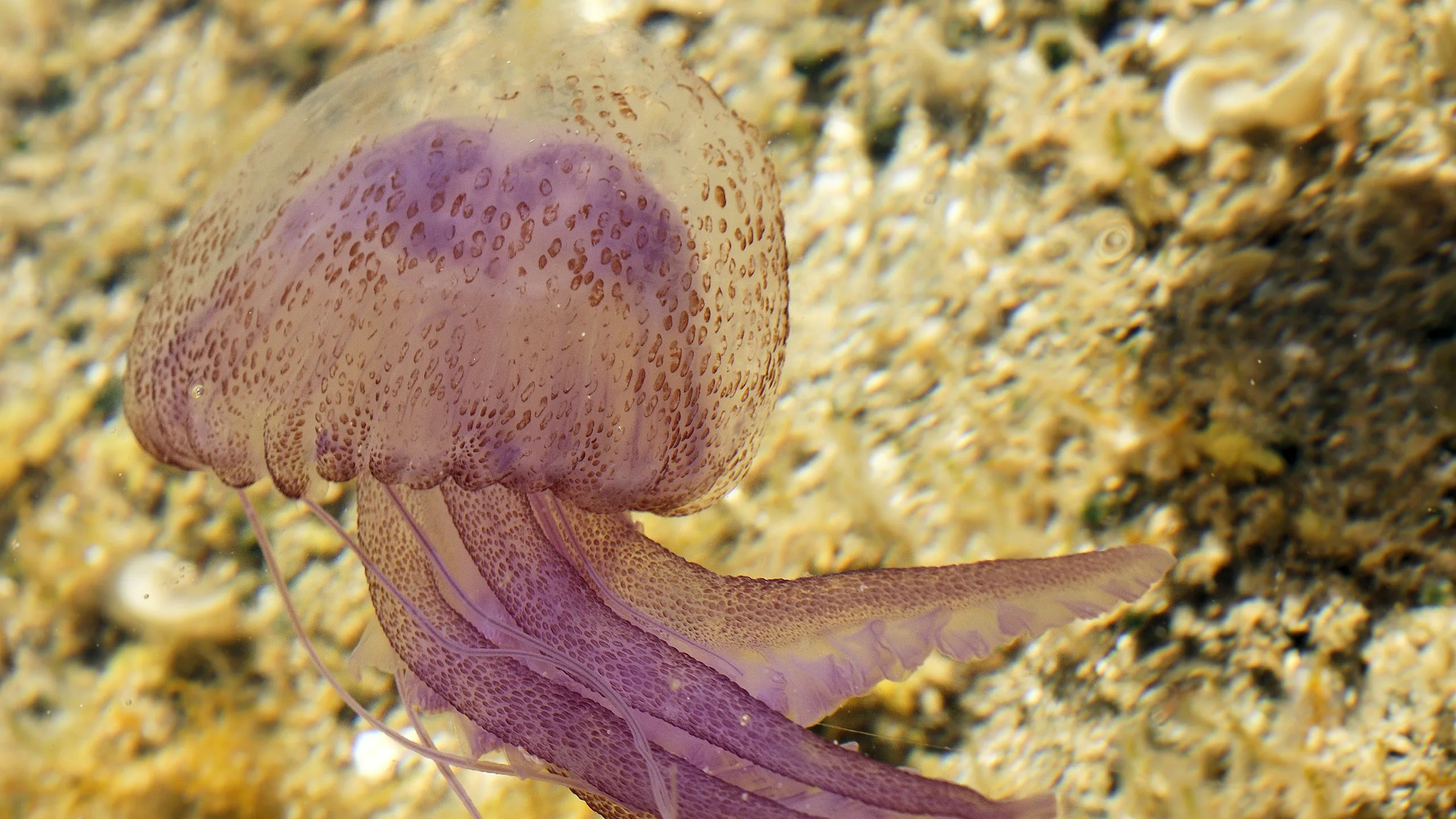
During the summer, Phyllorhiza punctata becomes more predominant. Olindias, although widely present, often goes unnoticed as people feel its sting without necessarily seeing it, especially in the regions of Sousse and Monastir. In winter, Bizerte experiences the frequent presence of Aurelia, from February to May. As we showed pictures of jellyfish to the fisherman Saber, he confirmed seeing Aurelia, Pelagia, and Rhizostoma frequently on Ghar El Melh coasts and, lately, even more often. He confirmed that these jellyfish are widespread in the sea, becoming increasingly prevalent.
Factors influencing jellyfish distribution
Drawing from the scientific research paper titled “Causes of Jellyfish Blooms and Their Influence on Marine Environment” published by the National Center for Biotechnology Information, several factors influence the distribution of jellyfish, with temperature playing a pivotal role in triggering the jellyfish season. Therefore, the interplay between temperature and food availability becomes a key determinant in the abundance of jellyfish. These informations are confirmed by Dr Gueroun, who revealed that coastal infrastructure, particularly the increase in marinas, plays a significant role as it is where polyps thrive. Under favorable conditions encompassing suitable temperatures and abundant food, the population of polyps increases, subsequently contributing to a higher presence of jellyfish.
Marinas, known for having less current and increased eutrophication, become optimal locations for polyps, offering ample food sources. Pollution in these areas indirectly impacts jellyfish abundance, as it leads to an increase in organic matter and phytoplankton. This surge in food sources contributes to the proliferation of jellyfish, given their diet of zooplankton and fish.
Dr. Sonia KM Gueroun
Based on Dr Gueroun’s statements, it is believed that the increase in jellyfish is multifactorial from climate change, increase in artificial shorelines, and decrease of jellyfish predators and competitors. Overfishing is a major factor in the increase in jellyfish in the water. Jellyfish and juvenile fish have the same food source: zooplankton. When both become abundant, they compete for resources.
However, overfishing drives out competitors (young fish), provides more food for the jellyfish and increases the number of jellyfish. In addition, jellyfish feed on fish larvae and eggs, further reducing competition with jellyfish. The complex relationship between overfishing and jellyfish prevalence highlights the complexity of ecosystems.
Jellyfish: Keystone species in aquatic ecosystems’ balance
Jellyfish play an important ecological role in maintaining the balance of marine life, acting as both predator and food source for other animals.
Many fish, including sunfish, large whales, turtles such as leatherback turtles, and seabirds, often include jellyfish in their diets, including poisonous jellyfish. Paradoxically, they are also prey for other large jellyfish and other gelatinous organisms. According to Dr Gueroun, until about 10 years ago, most people, including scientists’ research focus, had a mainly negative attitude towards jellyfish. They fed only on zooplankton and were the dead end in the ocean food web. However, recent discoveries have changed this view and shown that jellyfish are an important food source for a variety of organisms, the most known by the public, the sea turtles. However, jellyfish are an important prey for many fishes, seabirds, and crustaceans. Another aspect usually unknown to the public, is the role played by jellyfish for deep-sea ecosystems as they sink to the ocean floor and become food sources for other organisms. As a result, their absence can deprive other organisms of important prey and
upset the balance. Divers and snorkelers often witness relationships like this, where juvenile fish use jellyfish for what is assumed for protection and transportation, demonstrating an ecological partnership. Current research also investigates the hidden roles of jellyfish in trophic networks and to understand the different relationships between these gelatinous animals and other critters.
Invasion concerns: Exotic jellyfish species in Tunisia and the unexplored impact
Tunisia has two exotic species of Scyphomedusae: Rhopilema nomadica and Phylloriza punctata. According to Dr.Gueruon, while Rhopilema nomadica, is very burning and painful and can pose a danger to beachgoers, however, Phyllorhiza can be an issue for fishermen, especially Kerkennah where it is widespread in fishing nets (Charfia). His exotic species seeks higher temperatures and is often seen in Bizerte from July to August. However, they can be found on the southern coast of Tunisia starting from April. Although Rhopilema is included in the list of the top 100 most invasive species, it is not considered an invasive species in Tunisia. In contrast, Phylloriza is considered potentially invasive.
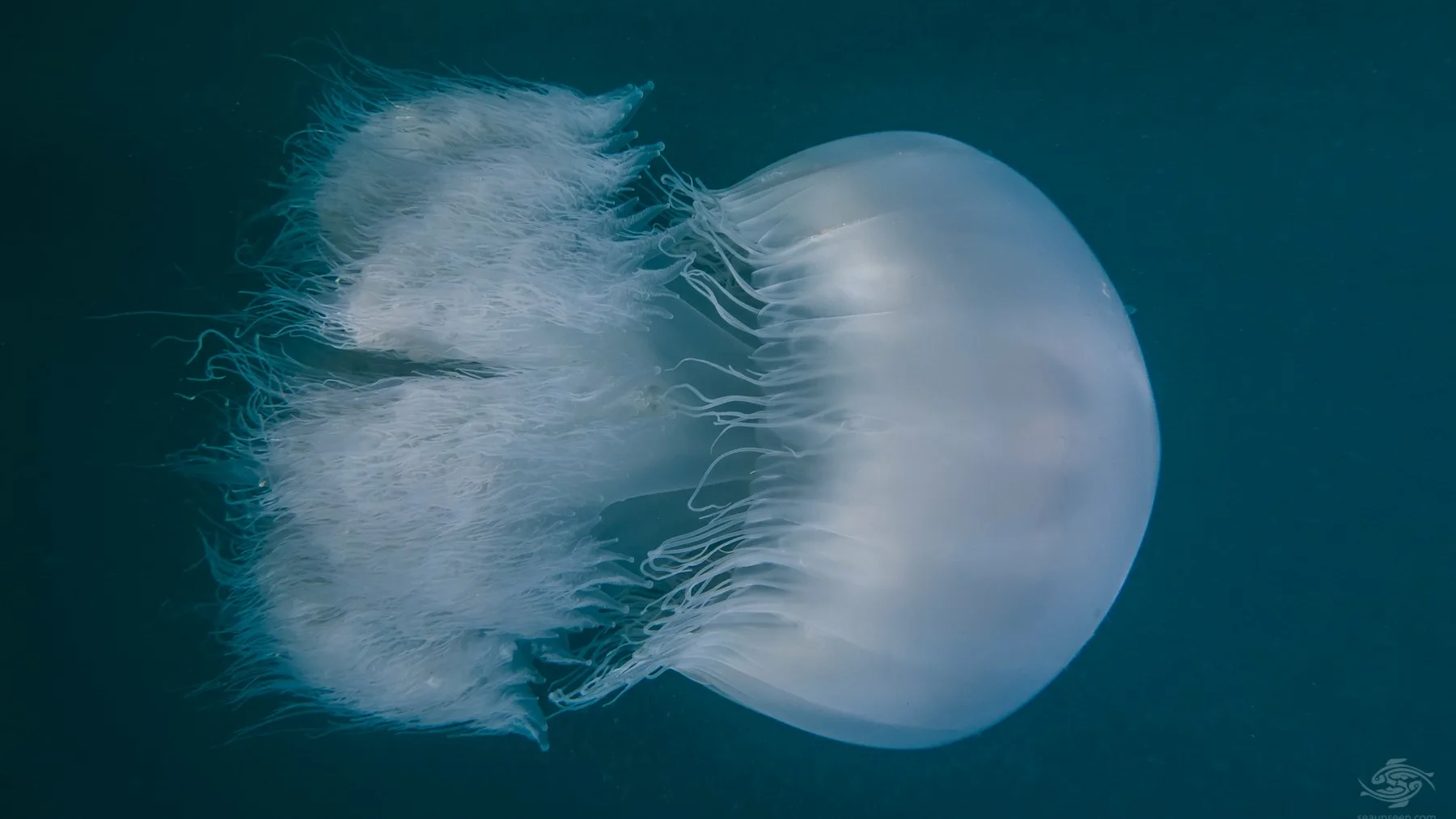
Giant nomad jellyfish (Rhopilema nomadica), photographed while snorkeling off the coast of Mafia Island. Copyright: Seaunseen.com
Nevertheless, no studies have been conducted in Tunisia to assess whether Phylloriza has a significant impact on the local ecosystem, and possibly on human activities. In the absence of such studies, the invasive status of Phyllorhiza in Tunisia remains uncertain.
Impacts of extreme jellyfish proliferation: A daily struggle for fishermen
Most fishermen have a negative attitude towards jellyfish, especially in the summer when more jellyfish are caught than fish in the area. This poses a significant challenge for Charfia species, especially Phylloriza species, and impacts Kerkennah’s traditional stationary fishery. Boulbeba Souisi, a young snorkeling instructor, sponge fisherman, and manager of the Kerkennah snorkeling club, admitted that fishermen battle jellyfish every day. Jellyfish in Charfia pose a problem as they sometimes outnumber fisheries, causing ongoing problems for local fishing communities. According to Dr.Gueroun, certain Mediterranean species, such as Pelagia Noctiluca, pose a severe problem for the aquaculture industry. In 2008, Monastir’s aquaculture cages experienced heavy mortality due to jellyfish breeding, resulting in damage to the fish’s gills.
From challenge to opportunity: Valorizing jellyfish proliferation
“Recognizing the solution to the proliferation of jellyfish lies in their valorization.” Declared Dr. Gueroun. Indeed various initiatives have emerged around the world. In Tunisia, jellyfish valorization is still in its infancy, exemplified by one company in Hammam Lif. Despite jellyfish not yet enjoying a favorable reputation in the country, this innovative idea adopted by the company of extracting collagen for cosmetic use showcases the potential for turning this challenge into an opportunity. This collaborative effort involves local fishermen, not only providing them with an additional income stream but also emphasizing the multifunctional aspects of jellyfish. Beyond collagen, there is a wide range of possibilities: food, agriculture, medicine, and biomimetics. The use of jellyfish as an edible food, reveals promising commercial avenues. The potential for export, particularly to Asia, underscores the versatility and diverse applications of jellyfish products, transforming them from a “pest” to a valuable resource.
In other regions, where jellyfish exploitation has been developed, the perception of jellyfish is positive. Jellyfish fishery is the first type of exploitation, with Thailand, India, Vietnam, Indonesia, and Latin America as emerging
Dr. Sonia KM Gueroun
producers and Japan and Korea as emerging markets. In the Gulf of California, a seasonal fishery for the cannonball jellyfish (Stomolophus meleagris) weas developed and local industry was created, transforming jellyfish into a source of income.
In Tunisia, one initiative has emerged in Hammam Lif, where Rhizostoma is abundant. They extract collagen from jellyfish for cosmetic purposes through a Tunisian company. This collaboration involves fishermen who catch the jellyfish for the enterprise, creating an additional source of income. Jellyfish are not only utilized for collagen but can also be an edible food, and multiple sources for commercial opportunities. There’s potential for export, particularly to Asia, leveraging the diverse applications of jellyfish products.
Raising awareness and strengthening the monitoring Tunisian network
In Tunisia, awareness initiatives regarding jellyfish are lacking. Dr. Gueroun emphasizes the need to educate people about the integral role jellyfish play in the ecosystem. They exist naturally, contributing to the balance of their habitat, and can be harnessed and valued. Human perception tends to focus on the negative aspects, overlooking the fact that not all jellyfish are harmful. There is a clear lack of awareness among the public. Dr. Gueroun suggests that negativity towards jellyfish will diminish once the concept of valorization is introduced.
Understanding that jellyfish are organisms with a specific role in their environment, and that their proliferation or invasion is a direct or indirect result of human intervention disrupting the marine ecosystem, can shift the negative perception. Efforts should be directed towards educating the public on the importance and potential benefits of jellyfish in order to foster a more informed and positive perspective.
Dr. Sonia KM Gueroun
An urgent need is also related to bolstering the monitoring network, which currently lacks sufficient research and data on jellyfish in Tunisia, Sonia KM Gueroun and her colleagues from the Faculty of Science of Bizerte and the National Agronomic Institute of Tunisia have taken the initiative. The only Citizen Science monitoring and reporting network for jellyfish in Tunisia is the Meduses.Tunisie established within the Med-Jellyrisk project framework in 2013. After the project concluded, Dr. Sonia KM Gueroun volunteered to manage this network. Presently, this network collaborates with the Tunsea Association to broaden its reach and collect more information. The goal is to bridge the existing data gap and increase awareness of jellyfish diversity in Tunisia.
Human activities are creating an environment conducive to the proliferation of jellyfish. Overfishing, depleting natural fish predators and competitors, disrupts marine food chains and fosters jellyfish development. Pollution from wastewater and fertilizers elevates nutrient levels, benefiting algae and plankton, and providing jellyfish with additional sustenance. The absence of natural checks on jellyfish populations, coupled with imbalances in marine ecosystems caused by human actions, contributes to their thriving presence in our oceans. Adapting to these ecosystem balance variations requires empowering valorization initiatives, turning challenges into opportunities. It also involves adopting a participative approach, supporting research and networks to gather essential data, manage the situation effectively, and maintain a healthy aquatic ecosystem.
This article was developed in collaboration with the Earth Journalism Network Mediterranean Media Initiative project.
Copyright © 2023 Blue Tunisia. All rights reserved
References:
